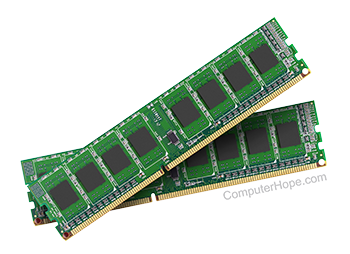Computer memory history

Listed below are the important events in history relating to computer memory, including release dates for many memory technologies.
See our computer hard drive history page for the history of hard drives.
1837
Charles Babbage first proposed the Analytical Engine, the first computer to use punch cards as memory and a way to program the computer.
1932
Gustav Tauschek developed drum memory in 1932.
1942
John Atanasoff successfully tested the ABC (Atanasoff-Berry Computer), the first computer to use regenerative capacitor drum memory.
1946
Freddie William's applied for a patent on his CRT (cathode ray tube) storing device on December 11, 1946. The device became known as the Williams tube or, more appropriately, the Williams-Kilburn tube. The tube only stored 128 40-bit words and was the first practical form of random-access memory.
Jan Rajchman began his work on developing the Selectron tube capable of storing 256 bits. Because of the popularity of magnetic core memory at the time, the Selectron tube was never put into mass production.
1947
Freddie William's memory system, known as the Williams-Kilburn tube, was in working order in 1947.
Frederick Viehe filed several of the first patents relating to magnetic-core memory. Others who helped with developing magnetic-core memory and magnetic drum memory include An Wang, Ken Olsen, and Jay Forrester.
1949
Jay Forrester and other researchers purposed using magnetic-core memory in the Whirlwind computer, in 1949.
1950
The United States government received the UNIVAC (Universal Automatic Computer) 1101 or ERA 1101. This computer was considered to be the first computer that was capable of storing and running a program from memory.
1951
Jay Forrester applied for a patent for magnetic-core memory, an early type of RAM (random-access memory), on May 11, 1951.
1952
In his master's thesis, Dudley Allen Buck described Ferroelectric RAM (FeRAM), which was not developed until the 1980s and early 1990s.
1953
In July 1953, a core memory expansion was added to the ENIAC (Electronic Numerical Integrator and Computer).
1955
Konrad Zuse completed the Z22, the seventh computer model and the first computer that used magnetic storage memory.
MIT (Massachusetts Institute of Technology) introduced the Whirlwind machine on March 8, 1955, a revolutionary computer that was the first digital computer with magnetic core RAM.
An Wang was issued U.S. patent #2,708,722 on May 17, 1955, for the invention of the magnetic "Pulse Transfer Controlling Device," which made magnetic core memory a reality.
Bell Labs introduced its first transistor computer. Transistors are faster, smaller, and create less heat than traditional vacuum tubs, making these computers more reliable and efficient.
1964
John Schmidt designed a 64-bit MOS (metal-oxide-semiconductor) p-channel Static RAM at Fairchild in 1964.
Kenneth Olsen was issued U.S. patent #3,161,861 on December 15, 1964, for magnetic core memory.
1968
On June 4, 1968, Dr. Robert Dennard at the IBM T.J. Watson Research Center was granted U.S. patent #3,387,286 describing a one-transistor DRAM (dynamic random-access memory) cell. DRAM would later replace magnetic core memory in computers.
1969
Charles Sie published a dissertation at Iowa State University describing and demonstrating phase-change memory called PRAM. Although PRAM had never been commercially practical, it was still being developed at companies like Samsung.
Intel released its first product, the 3101 Schottky TTL (transistor-transistor logic) bipolar 64-bit SRAM (static random-access memory). In the same year, Intel released the 3301 Schottky bipolar 1024-bit ROM (read-only memory).
1970
Intel released its first commercially available DRAM, the Intel 1103, in October 1970. It was capable of storing 1024 bits or 1 kb of memory.
1971
While at Intel, Dov Frohman invented and patented (#3,660,819) the EPROM (erasable programmable read-only memory) in 1971.
1974
While at Intel, Federico Faggin was granted patent #3,821,715 on June 28, 1974, which describes a memory system for a multichip digital computer.
1978
George Perlegos with Intel developed the Intel 2816, the first EEPROM (electrically erasable programmable read-only memory) in 1978.
1983
Wang Laboratories created the SIMM (single inline memory module) in 1983.
1984
Fujio Masuoka invented flash memory in 1984.
1993
Samsung introduced the KM48SL2000 SDRAM (synchronous dynamic random-access memory), and it quickly became an industry standard in 1993.
1996
DDR (double data rate) SDRAM (synchronous dynamic random-access memory) began being sold in 1996.
1999
RDRAM (Rambus Dynamic Random-Access Memory) became available for computers in 1999.
2003
DDR2 SDRAM began being sold in 2003.
XDR DRAM began being sold in 2003.
2007
DDR3 SDRAM began being sold in June 2007.
2014
DDR4 SDRAM began being sold in September 2014.
